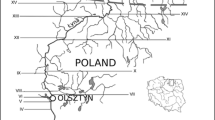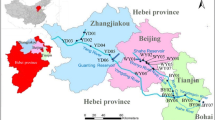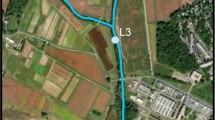Abstract
Rodrigo de Freitas Lagoon is an urban ecosystem undergoing accelerated degradation, therefore selected as a model for microbiological quality studies of tropical lagoons. The aim of this study was to evaluate the abundance and the spatial distribution of fecal pollution indicators and pathogenic microorganisms in the lagoon. The relationships between microbial groups and abiotic measurements were also determined to evaluate the influence of environmental conditions on bacterial distribution and to identify the capability of coliforms and Enterococcus to predict the occurrence of Vibrio, Staphylococcus aureus, and Salmonella. Surface water samples were collected monthly, from December 1999 to October 2000. Analyses were performed by traditional culture techniques. A uniform spatial distribution was observed for all bacterial groups. The fecal pollution indicators occurred in low abundances while potentially pathogenic microorganisms were consistently found. Therefore, our study supported the use of counts of coliforms and Enterococcus to indicate only recent fecal contamination.
Similar content being viewed by others
References
APHA (1998). Standard methods for the examination of water and wastewater. In L. S. Clesceri, A. E. Greenberg, & A. D. Eaton (Eds.), APHA/AWWA/WEF (20th ed.). Washington, DC: American Public Health Association.
Araujo, M. A., Guimarães, V. F., Mendonça-Hagler, L. C. S., & Hagler, A. N. (1990). Staphylococcus aureus and fecal streptococci in fresh and marine surface waters of Rio de Janeiro, Brazil. Revista de Microbiologia, 21(2), 141–147.
Araujo, F. V., Van Weerelt, M. D. M., Franco, G. M. O., Soares, C. G. A., Hagler, A. N., & Mendonça-Hagler, L. C. (1991). Classification based on coliform count of coastal waters in metropolitan Rio de Janeiro, Brazil. In O. T. Maggon, H. Convex, V. Tippie, L. T. Tobin, & D. Clarke (Eds.), Proceedings of the 7th symposium on coastal and ocean management—coastal zone 91 (pp. 3246–3258). New York: American Society of Civil Engineers.
Azam, F., & Long, R. A. (2001). Sea snow microcosms. Nature, 29, 497–498.
Baudart, J., Grabulos, J., Barusseau, J.-P., & Lebaron, P. (2000). Salmonella spp. and fecal coliform loads in coastal waters from a point vs. nonpoint source of pollution. Journal of Environmental Quality, 29(1), 241–250.
Borrego, J. J., Moriñigo, M. A., Vicente, A., Córnax, R., & Romero, P. (1987). Coliphages as an indicator of faecal pollution in water. Its relationship with indicator and pathogenic microorganisms. Water Research, 21(12), 1473–1480. doi:10.1016/0043-1354(87)90130-8.
Brito, I. M., & Lemos, E. E. (1982). Evolução geológica e fauna da Lagoa Rodrigo de Freitas, Rio de Janeiro. Anais da Academia Brasileira de Ciencias, 54(1), 143–164.
Bruni, V., Maugeri, T. L., & Monticelli, L. (1997). Faecal pollution indicators in the Terra Nova Bay (Ross Sea, Antarctica). Marine Pollution Bulletin, 34(11), 908–912. doi:10.1016/S0025-326X(97)00050-7.
Cloern, J. E. (1987). Turbidity as a control on phytoplankton biomass and productivity in estuaries. Continental Shelf Research, 7(11–12), 1367–1381. doi:10.1016/0278-4343(87)90042-2.
Costanza, R., d’Arge, R., Groot, R., Farber, S., Grasso, M., Hannon, B., et al. (1997). The value of the world’s ecosystem services and natural capital. Nature, 387, 253–260. doi:10.1038/387253a0.
Dionisio, L. P. C., Rheinheimer, G., & Borrego, J. J. (2000). Microbiological pollution of Ria Formosa (South of Portugal). Marine Pollution Bulletin, 40(2), 186–193. doi:10.1016/S0025-326X(99)00206-4.
Efstratiou, M., Mavridou, A., Richardson, S., & Papadakis, J. (1998). Correlation of bacterial indicator organisms with Salmonella spp., Staphylococcus aureus and Candida albicans in seawater. Letters in Applied Microbiology, 26, 342–346. doi:10.1046/j.1472-765X.1998.00345.x.
Elmanama, A. A., Fahd, M. I., Afifi, S., Abdallah, S., & Bahr, S. (2005). Microbiological beach sand quality in Gaza Strip in comparison to seawater quality. Environmental Research, 99, 1–10. doi:10.1016/j.envres.2004.12.014.
Empresa Brasileira de Pesquisa Agropecuária & Instituto Brasileiro do Meio Ambiente (1992). Identificação de limitações pedológicas e ambientais causadoras de degradação de áreas do Jardim Botânico do Rio de Janeiro. Séries Estudos e Contribuições, 10, 101 pp.
Evison, L. M. (1988). Comparative studies on the survival of indicator organisms and pathogens in fresh and seawater. Water Science and Technology, 20, 309–315.
Fujioka, R. S., Hashimoto, H. H., Siwak, E. B., & Young, R. H. F. (1981). Effect of sunlight survival of indicator bacteria in seawater. Applied and Environmental Microbiology, 41(3), 690–696.
Gonzalez, A. M., Paranhos, R., & Lutterbach, M. S. (2006). Heterotrophic bacteria abundances in Rodrigo de Freitas Lagoon (Rio de Janeiro, Brazil). Brazilian Journal of Microbiology, 37, 428–433. doi:10.1590/S1517-83822006000400005.
Guimarães, V. F., Araújo, M. A. V., Hagler, L. C. M., & Hagler, A. N. (1993). Pseudomonas aeruginosa and other microbial indicators of pollution in fresh and marine waters of Rio de Janeiro, Brazil. Environmental Toxicology and Water Quality, 8, 313–322. doi:10.1002/tox.2530080308.
Hagler, A. N., Mendonça-Hagler, L. C., Santos, E. A., Farage, S., Silva Filho, J. B., Schrank, A., et al. (1986). Microbial pollution indicators in Brazilian tropical and subtropical marine surface waters. The Science of the Total Environment, 58, 151–160. doi:10.1016/0048-9697(86)90084-7.
Høi, L., Larsen, J. L., Dalsgaard, I., & Dalsgaard, A. (1998). Occurrence of Vibrio vulnificus in Danish marine environments. Applied and Environmental Microbiology, 64, 7–13.
Ishizaka, J., Takahashi, M., & Ichimura, S. (1983). Evaluation of coastal upwelling effects on phytoplankton growth by simulated culture experiments. Marine Biology (Berlin), 76(3), 271–278. doi:10.1007/BF00393028.
Isobe, K. O., Tarao, M., Chiem, N. H., Minh, L. Y., & Takada, H. (2004). Effect of environmental factors on the relationship between concentrations of coprostanol and fecal indicator bacteria in tropical (Mekong Delta) and temperate (Tokyo) freshwaters. Applied and Environmental Microbiology, 70(2), 814–821. doi:10.1128/AEM.70.2.814–821.2004.
Kolm, H. E., Giamberardino Filho, R. E., & Korman, M. C. (1997). Spatial distribution and temporal variability of heterotrophic bacteria in the sediments of Paranaguá and Antonina Bays, Paraná, Brazil. Revista de Microbiologia, 28, 230–238.
Lebaron, P., Servais, P., Troussellier, M., Courties, C., Vives-Rego, J., Muyzer, G., et al. (1999). Changes in bacterial community structure in seawater mesocosms differing in their nutrient status. Aquatic Microbial Ecology, 19, 255–267. doi:10.3354/ame019255.
Légendre, L., & Légendre, P. (1998). Ecologie numérique. Tome 2: La structure des donnés écologiques. Collection d’Écologie, 13. Masson, Paris et les Presses de l’Université du Québec, 254 pp.
Lucas, L. M., & Cunha, S. B. (2007). Rede de drenagem urbana em área tropical: Mudanças na morfologia do canal e níveis de poluição das águas—Rio dos Macacos—Rio de Janeiro—RJ. GEOUSP—Espaço e Tempo, 22, 39–64.
Lutterbach, M. T. S., Vasquez, J. C., Pinet, J. A., Andreata, J. V., & da Silva, A. C. (2001). Monitoring and spatial distribution of heterotrophic bacteria and fecal coliforms in the Rodrigo de Freitas Lagoon, Rio de Janeiro, Brazil. Brazilian Archives of Biology and Technology, 44(1), 7–13. doi:10.1590/S1516-89132001000100002.
McCambridge, J., & McMeekin, T. A. (1981). Effect of solar radiation and predacious microorganisms on survival of fecal and other bacteria. Applied and Environmental Microbiology, 41(5), 1083–1087.
Pagnocca, F. C., Mendonça-Hagler, L. C., & Hagler, A. N. (1991). Heterotrophic bacteria associated with the shrimp Penaeus schmitti, sediment and water of Sepetiba Bay, Rio de Janeiro, Brazil. Revista de Microbiologia, 22(3), 247–252.
Pereira, M. G., & Alcântara, F. (1993). Culturability of Escherichia coli and Streptococcus faecalis in batch culture and “in situ” in estuarine water. Water Research, 27, 1351–1360. doi:10.1016/0043-1354(93)90223-5.
Pianetti, A., Bruscolini, F., Sabatini, L., & Colantoni, P. (2004). Microbial characteristics of marine sediments in bathing area along Pesaro-Gabicce coast (Italy): A preliminary study. Journal of Applied Microbiology, 97, 682–689. doi:10.1111/j.1365-2672.2004.02352.x.
Saliba, L. J., & Helmer, R. (1990). Health risks associated with pollution of coastal bathing waters. World Health Studies, 43, 177–187.
Secretaria Municipal de Meio Ambiente (1998). Programa de monitoramento dos ecossistemas costeiros urbanos do município do Rio de Janeiro. Rio de Janeiro: The Secretariat.
Solic, M., & Krstulovic, N. (1992). Separate and combined effects of solar radiation, temperature, salinity and pH on the survival of fecal coliforms in seawater. Marine Pollution Bulletin, 24(8), 411–416. doi:10.1016/0025-326X(92)90503-X.
Strickland, J. D. H., & Parsons, T. R. (1972). A pratical handbook of seawater analysis. Ottawa: Fisheries Research Board of Canada.
Torres, J. M. (1990). Lagoa Rodrigo de Freitas. Revista Municipal de Engenharia, XLI(1–4), 31–53.
Troussellier, M., Got, P., Bouvy, M., M’Boup, M., Arfi, R., Lebihan, F., et al. (2004). Water quality and health status of the Senegal River estuary. Marine Pollution Bulletin, 48, 852–862. doi:10.1016/j.marpolbul.2003.10.028.
Vieira, R. H. S., Rodrigues, D. P., Menezes, E. A., Evangelista, N. S. S., Reis, E. M. F., Barreto, L. M., et al. (2001). Microbial contamination of sand from major beaches in Fortaleza, Ceará State, Brazil. Brazilian Journal of Microbiology, 32, 77–80. doi:10.1590/S1517-83822001000200001.
Watkins, W. D., & Cabelli, V. J. (1985). Effect of fecal pollution on Vibrio parahaemolyticus densities in an estuarine environment. Applied and Environmental Microbiology, 49, 1307–1313.
West, P. A. (1989). The human pathogenic vibrios—a public health update with environmental perspectives. Epidemiology and Infection, 103, 1–34.
White, H. H., Draxler, A. F. J., Duncanson, R. A., Saad, D. L., & Robertson, A. (1993). Distribution of Clostridium perfringens spores in sediments around the 106-mile dumpsite in the mid-Atlantic Bight. Marine Pollution Bulletin, 26, 49–51. doi:10.1016/0025-326X(93)90598-E.
Wright, A. C., Hill, R. T., Johnson, J. A., Roghman, M.-C., Colwell, R. R., & Morris, G. M., Jr. (1996). Distribution of Vibrio vulnificus in the Chesapeake Bay. Applied and Environmental Microbiology, 62(2), 717–724.
Zar, J. H. (1999). Biostatistical analysis (2nd ed.). New Jersey: Prentice-Hall.
Author information
Authors and Affiliations
Corresponding author
Rights and permissions
About this article
Cite this article
Gonzalez, A.M., Paranhos, R. & Lutterbach, M.S. Relationships between fecal indicators and pathogenic microorganisms in a tropical lagoon in Rio de Janeiro, Brazil. Environ Monit Assess 164, 207–219 (2010). https://doi.org/10.1007/s10661-009-0886-9
Received:
Accepted:
Published:
Issue Date:
DOI: https://doi.org/10.1007/s10661-009-0886-9




